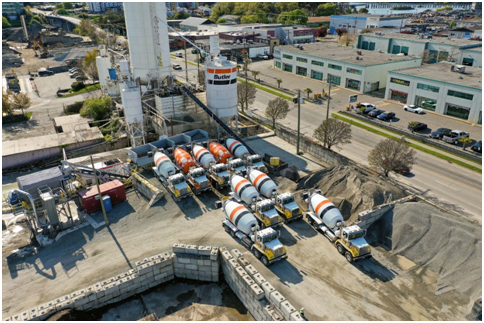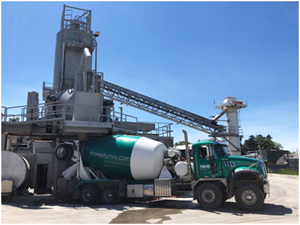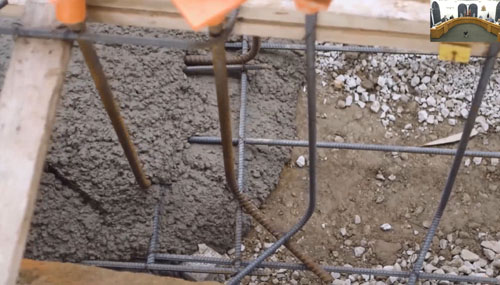Thursday November 18, 2021 | LANGFORD, BC [Updated November 23, 2021]
by Mary P Brooke, Editor | Island Social Trends
The City of Langford has become the first jurisdiction in Canada to adopt a low carbon concrete policy, boldly accelerating the deployment of technologies to decarbonize the built environment.
The policy was adopted at the city’s November 17 council meeting (rescheduled from November 15 due to the major wind and rainstorm impacting the region on that day).
Effective June 1, 2022, all concrete supplied to City-owned or solicited projects, and private construction projects greater than 50 cubic meters, will be required to be produced using post-industrial carbon dioxide (CO2) mineralization technologies, or an equivalent which offers concrete with lower embodied CO2.

Building regulations drive change:
“Building regulations are important drivers for change. This is an immediate and critical change that local governments can be a big part of,” said Langford Mayor Stew Young.
“While we have taken many steps to reduce our operational emissions, as a City, much of our impact comes from the materials that we buy. With this policy, Langford is extending its commitment to taking climate action while also setting a new, higher standard for policymakers across Canada to reign in emissions and protect our communities from the worst impacts of climate change,” the mayor said.
As one of the fastest growing cities in Canada, the City of Langford’s leadership on this issue has set the stage Canada-wide for policies that encourage carbon removal technologies for hard-to-abate emissions and innovative solutions to achieve emissions reductions in the built environment.
Modern cement production:
Embodied carbon emissions – resulting from construction activities and manufacturing of building materials – encompass all of the greenhouse gas emissions that are released before anyone even turns on the lights in a new building. Cement production, the key ingredient in concrete, is responsible for about seven percent of the world’s CO2 emissions. And concrete is the most used building material in the world, making it one of the largest contributors to embodied carbon in the built environment.
Carbonmineralization technologies inject captured CO2 into concrete during the mixing process where it becomes permanently embedded. This improves the concrete’s compressive strength, which then enables the reduction of carbon-intensive cement content in mix designs without impacting performance.
CO2 mineralization technologies for concrete are already widely used in Langford and surrounding communities. This policy was passed after comprehensive discussions with experts and industry leaders across Vancouver Island. The policy is also supported by local concrete producers Butler Concrete & Aggregate (based in Sooke) and Trio Ready-Mix (based in Esquimalt) and the West Shore Developers Association.
Concrete is always local:
The rep from Carbon Cure who made the presentation to Langford council on November 17 says “concrete is always local”, because it can only travel from 30 minutes up to an hour and still be usable.
Future high-tower buildings coming to Langford (such as the 18-storey and 21-storey buildings targeted for construction on Peatt Road and Sunderland Road) could contribute to a considerable capture of carbon if carbon-capture concrete is used in construction.
Langford Mayor Stew Young said during the November 17 council meeting that the local building industry would be given an opportunity to choose use of concrete suppliers. Young intends for there to be “a level playing field”, with time for the local ICL company in particular to catch up.
Young made it clear that Carbon Cure is not necessarily being given an edge on the local market by having made the public presentation at council.
Product declaration:

Langford’s new policy also requires that project teams submit – like a nutritional label for concrete – a product-specific Type III Environmental Product Declaration (EPD) that is 3rd-party verified. Adopting such a policy will enable Langford to track climate impacts of purchased concrete materials and take steps to reduce greenhouse gas emissions arising from local construction.
“By integrating this carbon mineralization policy, Langford is in a position to be the Canadian leader in the deployment of carbon capture, utilization, and storage (CCUS) technologies for concrete used in new construction,” said Vancouver Island resident Robert Niven, CEO of CarbonCure Technologies, a local supplier of carbon mineralization technologies for concrete.
Taking climate action:
While federal and global leaders discuss and debate climate commitments coming out of COP26, Langford seems to be proactively taking climate action that will have real and meaningful impact.
The industry very likely looks forward to other cities across British Columbia and Canada following suit by adopting a similar policy.
Business opportunity:
According to the Global Cement and Concrete Association (GCCA), carbon capture, utilization, and storage (CCUS) technologies are estimated to be the single largest decarbonization opportunity in the cement and concrete sector, accounting for more than one third of all emissions reductions needed to achieve net-zero production.
Leadership:
“What I’m most excited about is that Langford has created a transferable policy model to catalyze policy momentum nationwide – and globally – that will no doubt unleash more smart procurement policies to lower embodied carbon of concrete in new construction,” said Lisa Bate, the World Green Building Council Board’s immediate past chair and Global Sustainability Lead/Senior Principal at B+H Architects.
“The World Green Building Council’s Advancing Net Zero report highlighted the need for radical cross-sector coordination to revolutionize the construction sector toward a net zero future and tackle embodied carbon emissions. This policy solution in Langford is a wonderful demonstration of what’s possible,” said Bate.




